
Podocarpus latifolius is a large evergreen tree up to 35 m high and 3 m trunk diameter, in the conifer family Podocarpaceae; it is the type species of the genus Podocarpus.

The Orange River is a river in Southern Africa. It is the longest river in South Africa. With a total length of 2,432 km (1,511 mi), the Orange River Basin extends from Lesotho into South Africa and Namibia to the north. It rises in the Drakensberg mountains in Lesotho, flowing westwards through South Africa to the Atlantic Ocean. The river forms part of the international borders between South Africa and Lesotho and between South Africa and Namibia, as well as several provincial borders within South Africa. Except for Upington, it does not pass through any major cities. The Orange River plays an important role in the South African economy by providing water for irrigation and hydroelectric power. The river was named the Orange River in honour of the Dutch ruling family, the House of Orange, by the Dutch explorer Robert Jacob Gordon. Other names include simply the word for river, in Khoekhoegowab orthography written as !Garib, which is rendered in Afrikaans as Gariep River with the intrusion of a velar fricative in place of the alveolar click, Groote River or Senqu River, derived from ǂNū "Black". It is known in isiZulu as isAngqu.

Curtisia dentata is a flowering tree from Southern Africa. It is the sole species in genus Curtisia, which was originally classed as a type of "dogwood" (Cornaceae), but is now placed in its own unique family Curtisiaceae.
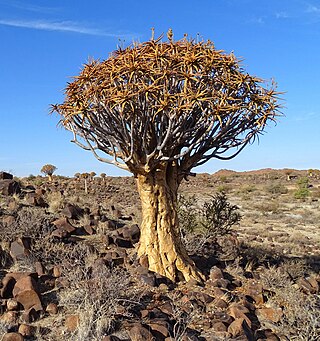
Aloidendron dichotomum, formerly Aloe dichotoma, the quiver tree or kokerboom, is a tall, branching species of succulent plant, indigenous to Southern Africa, specifically in the Northern Cape province of South Africa, and parts of Southern Namibia.

The Gariep Dam is located in South Africa, near the town of Norvalspont, bordering the Free State and Eastern Cape provinces. Its primary purpose is for irrigation, domestic and industrial use as well as for power generation. It the largest dam in South Africa.

Table Mountain National Park, previously known as the Cape Peninsula National Park, is a national park in Cape Town, South Africa, proclaimed on 29 May 1998, for the purpose of protecting the natural environment of the Table Mountain Chain, and in particular the rare fynbos vegetation. The park is managed by South African National Parks. The property is included as part of the UNESCO Cape Floral Region World Heritage Site.
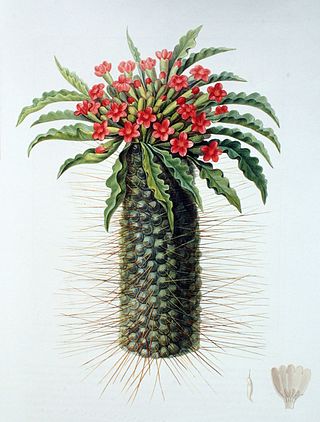
Pachypodium namaquanum, also known as halfmens or elephants trunk, is a succulent plant of Southern Africa. The genus name Pachypodium is from the Greek for 'thick foot', an allusion to its swollen base, while the species name namaquanum is a reference to Namaqualand.
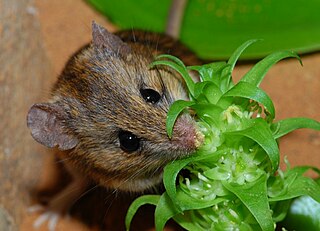
The Namaqua rock rat is a species of rodent in the family Muridae. It is sometimes included in the genus Micaelamys. It is found in Angola, Botswana, Lesotho, Malawi, Mozambique, Namibia, South Africa, Eswatini, Zambia, and Zimbabwe. Its natural habitats are temperate forest, dry savanna, temperate shrubland, subtropical or tropical dry shrubland, temperate grassland, rocky areas, hot desert, temperate desert, rocky shores, arable land, rural gardens, and urban areas.
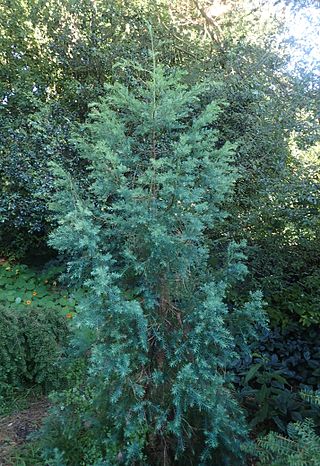
Widdringtonia schwarzii is a species of Widdringtonia native to South Africa, where it is endemic to the Baviaanskloof and Kouga Mountains west of Port Elizabeth in Eastern Cape Province; it occurs on dry rocky slopes and crags at 600–1,200 m altitude. It is threatened by habitat loss, particularly by wildfire. The Willowmore cypress is a protected tree in South Africa.

The Karoo toad, Gariep toad, or mountain toad is a species of toad in the family Bufonidae found in southern Namibia, much of South Africa, Lesotho, and Eswatini. It is an abundant species that occurs in many types habitat: fynbos heathland, succulent karoo, thickets, grassland, and Nama Karoo. Breeding takes place in permanent and temporary waterbodies. There are no significant threats to this adaptable species.

The Namaqua rain frog or Namaqua short-headed frog is a species of frogs in the family Brevicipitidae. It is found in Namaqualand in western South Africa and extreme southern Namibia.

Erythrophysa transvaalensis is a species of plant in the family Sapindaceae. It is a protected tree in South Africa. It is found in Botswana, South Africa, and Zimbabwe. Its range is disjunct however, so that suggestions have been made that its seeds were formerly employed as beads, which assisted its dispersal along ancient trade routes.

Oviston Nature Reserve is a protected area in the Eastern Cape Province, South Africa. The nature reserve is managed by Eastern Cape Parks. It is located on the southern shores of the Gariep Dam.
The Namaqua rock gecko or Namaqua flat gecko is a species of African geckos found in South Africa.
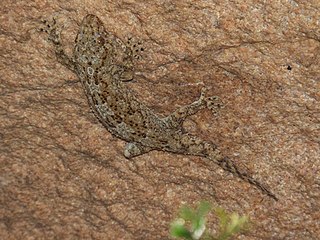
The Namaqua thick-toed gecko is a species of lizard in the family Gekkonidae. It is found in Namibia and South Africa.
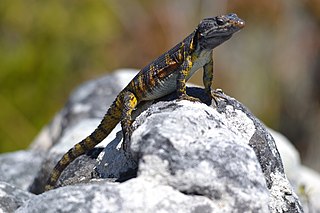
Pseudocordylus microlepidotus, or the Cape crag lizard, is a species of lizard native to shrublands and grasslands of South Africa. Three subspecies have been named: Pseudocordylus microlepidotus microlepidotus, Pseudocordylus microlepidotus fasciatus, and Pseudocordylus microlepidotus namaquensis. The species' gestation type is ovoviviparous. The species is protected under Convention on International Trade in Endangered Species of Wild Fauna and Flora (CITES).

Pedioplanis namaquensis, known commonly as the Namaqua sand lizard or l'Érémias namaquois, is a species of lizard in the family Lacertidae. The species is endemic to Southern Africa.
Acontias namaquensis, the Namaqua legless skink or Namaqua lance skink, is a species of lizard in the family Scincidae. It is endemic to Little Namaqualand, Northern Cape, South Africa.
The Namaqua girdled lizard is a species of small, spiny lizard in the family Cordylidae. The species is native to Namibia and South Africa.

Philip Herd Nature Reserve is a nature reserve within the UNESCO Vhembe Biosphere Reserve in the Vhembe District of Limpopo Province, South Africa. The reserve is located east of the town of Musina on the Limpopo River which forms the border between South Africa and Zimbabwe. It covers an area of 12,000 hectares (Ha), of which 6,616.42 Ha is a declared protected area in terms of South Africa's National Environmental Management Act: Protected Areas Act of 2003. The reserve conserves a critically biodiverse area of Limpopo Ridge Bushveld and 1.5% of the Nzhelele River catchment, which forms part of the Limpopo Water Management Area (WMA) established in terms of South Africa's National Water Act of 1998. The reserve operates under the brand name, The Herd Reserve.


















